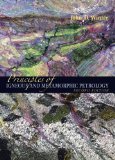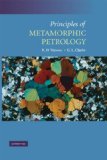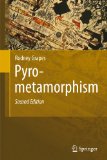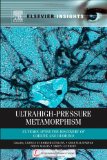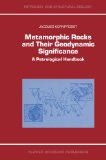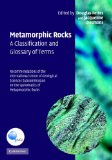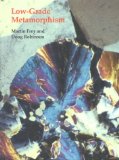|
Principles of Igneous and Metamorphic Petrology (2nd Edition)
With enough background to be rigorous, yet not exhaustive, this book offers good preparation in the techniques of modern petrology; a clear and organized review of the classification, textures, and approach to petrologic study; and applies these concepts to the real occurrences of the rocks themselves. The goal throughout is for readers to be able to apply the techniques—and enjoy the insights of the results—rather than tinker with theory and develop everything from first principles. A survey of actual occurrences of igneous and metamorphic rocks, and processes that produce them, is provided. This section is often greatly condensed in most other books, but it is the most interesting and dynamic aspect of petrology. |

|
Igneous and Metamorphic Rocks under the Microscope: Classification, textures, microstructures and mineral preferred orientation
This is the first modern text to provide a thorough integrated treatment of those parts of the subject that use the polarizing microscope as the central analytical tool. The book is divided into three parts and a comprehensive glossary/index provides easy access to the contents of the book. |
|
Principles of Metamorphic Petrology
Principles of Metamorphic Petrology provides a modern introduction to the latest ideas, techniques and approaches in the study of metamorphic rocks. The book begins with basic concepts, but advances further than most other metamorphic petrology texts. Examples of this include the latest chemographic approaches, the correct use of pseudosections and the application of x-ray compositional mapping to metamorphic problems. It also covers recent advances in thermobarometry and the application of modern geochronological techniques to the absolute timing of tectonometamorphic events. Determination of parent rocks is covered in detail and there is a modern exposition of partial melting reactions, melt extraction and deformation of migmatites. The book includes a large number of references to lead students into independent investigation. A valuable text for advanced undergraduate and graduate courses in metamorphic petrology, that serves as the most current reference for researchers and exploration geologists. |
|
High-Temperature Metamorphism and Crustal Anatexis
|
|
Pyrometamorphism
1000 °C and low pressures (< 2 kb) and typically results in the formation of "burnt" and fused rocks termed buchites, paralavas, clinkers and fulgarites. It is typically associated with shallow basaltic intrusions (contact aureoles, xenoliths,) combustion of carbonaceous matter, lightning strikes, and is also found in meteorites. During pyrometamorphism, the sequence of heating and cooling is greatly condensed favouring the preservation of a variety of stranded reaction microstructures that reflect disequilibrium reaction kinetics with metastable and mineral crystallisation. This second edition includes the latest developments in the study of pyrometamorphism derived from over 60 new references and accompanied with over 20 new illustrations. |
|
Ultrahigh-Pressure Metamorphism: 25 Years After The Discovery Of Coesite And Diamond
Ultrahigh pressure metamorphism (UHPM) is a relatively new but fast growing discipline related to the deep subduction of slabs of continental and/or oceanic crust into the Earth's mantle and their return towards the surface as important components of mountain belts. The discipline was established ~25 years ago after discoveries of high pressure minerals, coesite and diamond, in the rocks of the continental affinities, a place where such minerals are "forbiden"according to main geological concepts. Exposures of HP/UHP rocks, once thought to be restricted to European Mountain systems, are being found in Asia, Africa, South and North Americas and Greenland. They provide us with valuable information on the mineral assemblages, fluid inclusions, microstructures, rheologies, major and trace element chemistries, stable and radiogenic isotope characteristics and timing relationships in slabs that have been subducted to depth up to some 200-250 km. Geologic processes under UHP conditions are by their very nature difficult to unravel because of the intense overprinting experienced by the rocks on their way back up to the Earth's surface. However, detailed studies in outcrops and in mineral/rock slides in laboratories with the aid of advanced state-of-art analytical instruments and techniques provide unprecedented integrated knowledge about processes operating in deep Earth's horizons at converging plate boundaries. UHPM rocks consist of the fragments of continental and oceanic crustal rocks and associated mafic-ultramafic intrusions and/or mantle peridotite initially formed at shallow lithosphere, but which subsequently have experienced a recrystallization within or above coesite and diamond stability fields (>2.7 - 4 GPa, ~700 - 1000oC). Before coesite and diamond discoveries, the eclogites and peridotites that are characteristic of UHPM terranes were considered geological curiosities of limited occurrence and significance. The number of Geoscientists working on HP/UHP and related rocks has been increasing steadily each year as their significance has become more and more apparent, numbering now several hundred extremely active international scientists.The current explosion of research on UHPM terranes reflects their significance for understanding large scale mantle dynamics, major elements of plate tectonics such as continental collisions, deep subduction and exhumation, mountains building, geochemical recycling "from surface to the core", and a deep storage of light elements participating in green-house effects in the atmosphere. |
|
Metamorphic Crystallization
Metamorphic Crystallization investigates the upper regions of the crystalline Earth, where countless solid-state chemical changes have taken place during the long history of the planet. The exploration proceeds in five stages. Firstly, a brief reminder of the importance of field, microscopic, and experimental phase-equilibrium results in metamorphic studies is given, followed by a review of classical thermodynamics as applied to minerals. Different kinds of mineral equilibria are defined, and representative natural and experimental examples of each kind are examined. The kinetics of reactions involving crystals (reaction rate, diffusion, nucleation, crystal growth), referring to certain experiments that have provided information on these microprocesses, are reviewed. Finally, the granular microstructure of natural samples (crystal shape, size, spatial distribution) together with chemical data are examined, and an interpretation of these observations in terms of mineral kinetics is pursued. This exploration intends to leave the reader more appreciative of changes which occur within the Earth, and more interested in the application of thermodynamics and kinetics in the study of these changes. |
|
Metamorphic Rocks and Their Geodynamic Significance: A Petrological Handbook
This book describes metamorphic rock formation mechanisms in a simplified form. It presents the geometrical rules which control mineral assemblages as a function of rock composition, and provides the basis of a thermodynamical approach used for equilibrium slope calculations as well as for the evaluation of P, T stability fields of mineral associations. On the basis of several examples from the literature, the author emphasizes the relations between different metamorphic gradients and different geodynamic situations. Associated P-T-t paths are examined from several points of view including the respective roles of heat conduction and convection. Audience: This textbook will be useful to undergraduate students in geology, but also to research students and scientists needing to rapidly update their knowledge of metamorphism. It is also accessible to anybody interested in geosciences wanting to acquire a basic knowledge of the close relationships that exist between geodynamics and metamorphic processes. |
|
Metamorphic Rocks: A Classification and Glossary of Terms: Recommendations of the International Union of Geological Sciences Subcommission on the Systematics of Metamorphic Rocks
Many common terms in metamorphic petrology vary in their usage and meaning between countries. The International Union of Geological Sciences (IUGS) Subcommission on the Systematics of Metamorphic Rocks (SCMR) has aimed to resolve this, and to present systematic terminology and rock definitions that can be used worldwide. This 2007 book is the result of discussion and consultation lasting 20 years and involving hundreds of geoscientists worldwide. It presents a complete nomenclature of metamorphic rocks, with a comprehensive glossary of definitions, sources and etymology of over 1200 terms, and a list of mineral abbreviations. Twelve multi-authored sections explain how to derive the correct names for metamorphic rocks and processes, and discuss the rationale behind the more important terms. These sections deal with rocks from high- to low- and very-low-grade. This book will form a key reference and international standard for all geoscientists studying metamorphic rocks. |
|
Low-Grade Metamorphism
Low-Grade Metamorphism explores processes and transformations in rocks during the early stages of metamorphic recrystallization. There has been little analysis and documentation of this widespread phenomenon, especially of the substantial and exciting advances that have taken place in the subject over the last decade. This book rectifies that shortfall, building on the foundations of Low-Temperature Metamorphism by Martin Frey (1987). The editors have invited contributions from an internationally acknowledged team of experts, who have aimed the book at advanced undergraduate and graduate students as well as researchers in the field. |






























